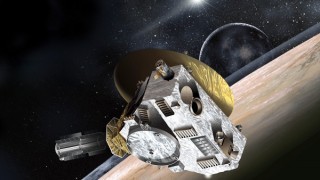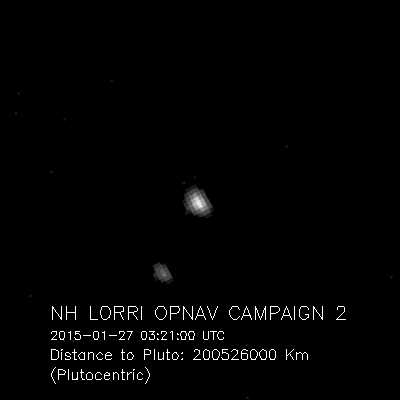
NASA’s New Horizons probe has started sending back its first images of Pluto, around 126 million miles away from its target destination. The snaps were taken using an instrument called the Long-Range Reconnaissance Imager (LORRI) on Jan. 25 and Jan. 27 - the 109th birthday of Clyde Tombaugh, the American astronomer who first discovered Pluto.
With the distance between New Horizons and Pluto being so high, the resolution of the image isn’t exactly spectacular. The pixellated picture shows the dwarf planet and its biggest moon, Charon. Pluto’s other four moons cannot be discerned in the new photo, however.

While the image may not seem particularly impressive at first glance, it represents one of the first pieces of information to be beamed back to Earth on New Horizons’ historic mission.
It’s also an opportunity for NASA to ensure some of its key instruments are fully operational, while also checking the probe’s alignment and trajectory. Controllers will be performing optical navigation surveys, with officials set to scour the craft’s path for potential obstructions.
Costing around $700 million, the New Horizons mission was launched back in 2006, in the hope it would provide astronomers with greater insight into Pluto and its many moons. The New Horizons probe is expected to reach Pluto on July 14, 2015, and will be a milestone in space exploration.
“My dad would be thrilled with New Horizons,” stated Clyde Tombaugh’s daughter, Annette Tombaugh. “To actually see the planet that he had discovered, and find out more about it - to get to see the moons of Pluto - he would have been astounded. I’m sure it would have meant so much to him if he were still alive today.”
When New Horizons is at its closest approach to Pluto, it will take pictures with much greater detail. LORRI will make a series of observations of the dwarf planet’s surface at a resolution of 100 meters per pixel. The team responsible for spearheading the mission will use the probe’s array of instruments to map the surface composition of both Pluto and Charon, as well as their temperature and geological structure. The team will also use New Horizons to hunt down additional rings and moons.
Once the primary mission has been completed, the team will seek approval from NASA to extend the mission and study another object within the Kuiper Belt. If the mission gets the green light, the flyby is expected to take place in 2019.
